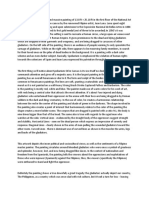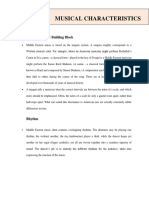The Gleaners (Des Glaneuses) Is An: Oil Painting Jean-François Millet 1857 Gleaning Wheat
The Gleaners (Des Glaneuses) Is An: Oil Painting Jean-François Millet 1857 Gleaning Wheat
Uploaded by
Daniel DiazOriginal Description:
Original Title
Copyright
Available Formats
Share this document
Did you find this document useful?
Is this content inappropriate?
Report this DocumentCopyright:
Available Formats
The Gleaners (Des Glaneuses) Is An: Oil Painting Jean-François Millet 1857 Gleaning Wheat
The Gleaners (Des Glaneuses) Is An: Oil Painting Jean-François Millet 1857 Gleaning Wheat
Uploaded by
Daniel DiazCopyright:
Available Formats
The Painters Studio
This painting portrays the artist in the center with the awful side of his life on the left side of
him and the good side of his life on the right side of him. The left side represents challenge
and opposition (figures like beggars and prostitutes) while the right represents friends and
admirers.
The painting exhibits a heightened reality that makes it almost dreamlike, with figures that are
both real and symbolic.
17. This painting is considered great because it is so original and unique in its blending of the
allegorical and the actual so that the difference is almost impossible to distinguish.
Burial At Ornans
This painting is an early example of Realism, before it became too well known or well-liked among
the public, so it was met with some fierce denunciations from the critics and the public. It is the
depiction of the funeral of his grand uncle, in a style that was usually reserved for religious or royal
scenes. The actual townspeople who attended the funeral were used as models.
The people in the crowd are not depicted in a lavish or idealistic way, but as they are and as they
truly looked in real life, ugliness and all. The figures are not doing dramatic grieving gestures, but are
posed rather realistically, which was very seldom done at the time in works of art.
This work is great because it was one of the first Realist paintings, and extremely innovative for the
time in its subject matter and the way the scene is presented. It stripped away all traditional or,
popular conventions for the fine art of that era, and ushered in a new movement. Because of this
the painting has been referred to as, The Burial of Romanticism.
The Gleaners (Des glaneuses) is an oil painting by Jean-Franois Millet completed in 1857. It
depicts three peasant women gleaning a field of stray grains of wheat after the harvest. The painting
is famous for featuring in a sympathetic way what were then the lowest ranks of rural society; this
was received poorly by the French upper classes.
You might also like
- The SpolariumDocument32 pagesThe Spolariummjgielyn100% (9)
- Spoliarium Critique Paper by MissamorDocument2 pagesSpoliarium Critique Paper by MissamorLourdes Amor100% (4)
- Skill ExerciseDocument3 pagesSkill ExerciseDaniel DiazNo ratings yet
- Gr11 Realism 2022Document45 pagesGr11 Realism 2022bjenfaNo ratings yet
- Art App 1Document15 pagesArt App 1ellaNo ratings yet
- Realism: Christina's World by Andrew Wyeth, 1948Document16 pagesRealism: Christina's World by Andrew Wyeth, 1948Pralea Vladimir100% (1)
- REALISM WPS OfficeDocument32 pagesREALISM WPS OfficeJanry MoralNo ratings yet
- REALISMDocument6 pagesREALISMjemuelpachecoNo ratings yet
- Realism Britannica Online EncyclopediaDocument5 pagesRealism Britannica Online EncyclopediaThương NguyễnNo ratings yet
- Art in 19th Century EuropeDocument6 pagesArt in 19th Century EuropeSarah Mishra100% (1)
- ArtsDocument19 pagesArtsAldren Cruz100% (1)
- Industrial Revolution and Its Impact On ArtDocument2 pagesIndustrial Revolution and Its Impact On ArtNazmul HasanNo ratings yet
- Art Movement (Romanticism and Realism)Document10 pagesArt Movement (Romanticism and Realism)pramadhitasetraNo ratings yet
- Realism - Conceptual Art: Art Movements and StylesDocument18 pagesRealism - Conceptual Art: Art Movements and StylesKhyla DonatoNo ratings yet
- Realism Was An Artistic Movement That Began in France in The 1840s, After The 1848Document6 pagesRealism Was An Artistic Movement That Began in France in The 1840s, After The 1848Ellie Jane MapaNo ratings yet
- Realism (1840s - 1880s)Document9 pagesRealism (1840s - 1880s)Keane ChuaNo ratings yet
- RealismDocument22 pagesRealismFatima Erica I. DatumangudaNo ratings yet
- I. Realism: - Gustave Courbet - Edouard ManetDocument24 pagesI. Realism: - Gustave Courbet - Edouard ManetLouis Gen FloresNo ratings yet
- Critique Paper About SpoliariumDocument2 pagesCritique Paper About SpoliariumLourdes Amor100% (1)
- Critique Paper About SpoliariumDocument2 pagesCritique Paper About SpoliariumLourdes AmorNo ratings yet
- Sometimes The Paintings That Have TheDocument5 pagesSometimes The Paintings That Have TheMark Kenneth CeballosNo ratings yet
- Neoclassicism and RomanticismDocument5 pagesNeoclassicism and RomanticismJm100% (2)
- .Realism: Mariñas, Angelyn O. A (Art Movement)Document2 pages.Realism: Mariñas, Angelyn O. A (Art Movement)Jhane Paleb BalagotNo ratings yet
- A Guide To Romanticism, Realism, and Expressionism in ArtDocument5 pagesA Guide To Romanticism, Realism, and Expressionism in ArtRowena Odhen UranzaNo ratings yet
- Rosa Bonheur PDFDocument10 pagesRosa Bonheur PDFIolandaTomiucNo ratings yet
- LESSON 2.1 - Methods of Pressenting Arts Subjects PDFDocument39 pagesLESSON 2.1 - Methods of Pressenting Arts Subjects PDFChena Berna RolloNo ratings yet
- Buonarroti MichaelangeloDocument105 pagesBuonarroti Michaelangelosvetlana0% (1)
- Art MovementsDocument26 pagesArt Movementsfreaann03No ratings yet
- Rembrandt Harmenszoon Van RijnDocument7 pagesRembrandt Harmenszoon Van RijnKavel LallaNo ratings yet
- History of RealismDocument2 pagesHistory of RealismPearl ArcamoNo ratings yet
- Realism Research PaperDocument22 pagesRealism Research PaperHAAHHAHAHHANo ratings yet
- RomanticismDocument84 pagesRomanticismOMPRAKASH GUPTANo ratings yet
- Courbet Burial at Ornans Script PDFDocument4 pagesCourbet Burial at Ornans Script PDFnadiaNo ratings yet
- RealismDocument3 pagesRealismVerneiza Pabiran BalbastroNo ratings yet
- Video Study Questions ImpressionistDocument2 pagesVideo Study Questions ImpressionistJohn CalvertNo ratings yet
- RealismDocument16 pagesRealismMukul BishwasNo ratings yet
- Methods of Presenting Art SubjectDocument39 pagesMethods of Presenting Art SubjectJef JepoyNo ratings yet
- Les Romains de La DécadenceDocument3 pagesLes Romains de La DécadenceDaniel OrtegaNo ratings yet
- Arts Research (Artists)Document25 pagesArts Research (Artists)Louis Gen FloresNo ratings yet
- Age of RomanticismDocument3 pagesAge of RomanticismKIARA VENICE DELGADONo ratings yet
- Wimsey the Bloodhound's Institute of Houndish Art Volume OneFrom EverandWimsey the Bloodhound's Institute of Houndish Art Volume OneNo ratings yet
- RealismDocument5 pagesRealismgwhvb57vmcNo ratings yet
- Neoclassicism: Characteristics of Neoclassical PaintingDocument5 pagesNeoclassicism: Characteristics of Neoclassical Paintingvishant vikashNo ratings yet
- Artists of The 20th and 21st CenturyDocument22 pagesArtists of The 20th and 21st CenturyScribdTranslationsNo ratings yet
- ROMANTICISMDocument26 pagesROMANTICISMerica facundoNo ratings yet
- EXPRESSIONISMDocument28 pagesEXPRESSIONISMAnna PoblacionNo ratings yet
- Neo-Classical Period - ArtDocument14 pagesNeo-Classical Period - ArtkukuhpaigeNo ratings yet
- SpolariumDocument18 pagesSpolariumMarvin GwapoNo ratings yet
- Subject of ArtDocument72 pagesSubject of ArtBi BengNo ratings yet
- RealismDocument9 pagesRealismfrancesaliyah28No ratings yet
- Methods of Art Production and PresentationDocument4 pagesMethods of Art Production and PresentationeloyzamacababbadNo ratings yet
- Document10 1Document3 pagesDocument10 1api-299648045No ratings yet
- Mapeh Arts W3Document12 pagesMapeh Arts W3Nicole Faye RamosNo ratings yet
- Fernand LégerDocument27 pagesFernand Légerming tongNo ratings yet
- SpoliariumDocument4 pagesSpoliariumJanice AlangNo ratings yet
- THE BIRD SEL-WPS OfficeDocument4 pagesTHE BIRD SEL-WPS OfficeJOYCE LORRAINE OSIMNo ratings yet
- Nochlin, Linda - The Imaginary OrientDocument27 pagesNochlin, Linda - The Imaginary OrientCatarina SantosNo ratings yet
- Fys Argument PaperDocument7 pagesFys Argument Paperapi-726084407No ratings yet
- O Clap Your Hands: Source: "Cathedral Music", William Boyce, 1788, Vol 2 Page 59 Orlando Gibbons (1583-1625)Document18 pagesO Clap Your Hands: Source: "Cathedral Music", William Boyce, 1788, Vol 2 Page 59 Orlando Gibbons (1583-1625)Daniel DiazNo ratings yet
- L e A V e SDocument2 pagesL e A V e SDaniel DiazNo ratings yet
- If You Come BackDocument1 pageIf You Come BackDaniel DiazNo ratings yet
- Music 3 Subject DescriptionDocument2 pagesMusic 3 Subject DescriptionDaniel DiazNo ratings yet
- Si Malakas at Si MagandaDocument7 pagesSi Malakas at Si MagandaDaniel DiazNo ratings yet
- Rhythms of CordilleraDocument1 pageRhythms of CordilleraDaniel DiazNo ratings yet
- Criteria For JudgingDocument1 pageCriteria For JudgingDaniel DiazNo ratings yet
- Musical Characteristics: Scales-The Basic Building BlockDocument4 pagesMusical Characteristics: Scales-The Basic Building BlockDaniel DiazNo ratings yet
- SAMPLE HAIKU (Japanese Short Poems)Document3 pagesSAMPLE HAIKU (Japanese Short Poems)Daniel DiazNo ratings yet
- Rhythms of CordilleraDocument1 pageRhythms of CordilleraDaniel DiazNo ratings yet
- SMB - Music 3 (Diaz)Document4 pagesSMB - Music 3 (Diaz)Daniel DiazNo ratings yet
- Formative Test in Music 3Document2 pagesFormative Test in Music 3Daniel DiazNo ratings yet
- Project Title Munting Tinig at Tugtugan Proponent ProjectDocument2 pagesProject Title Munting Tinig at Tugtugan Proponent ProjectDaniel DiazNo ratings yet
- Tone and MoodDocument6 pagesTone and MoodDaniel DiazNo ratings yet
- 15th International Chamber Choir Competition Marktoberdorf 2017Document5 pages15th International Chamber Choir Competition Marktoberdorf 2017Daniel DiazNo ratings yet
- 9 Music LM - Mod.1.v1.0Document33 pages9 Music LM - Mod.1.v1.0Daniel Diaz100% (1)
- Historical Research DiazDocument3 pagesHistorical Research DiazDaniel Diaz0% (1)
- The Little RainDocument2 pagesThe Little RainDaniel Diaz71% (7)
- Types of PoemDocument2 pagesTypes of PoemDaniel DiazNo ratings yet
- Deped Memorandum No. 146 December 2014Document3 pagesDeped Memorandum No. 146 December 2014Daniel DiazNo ratings yet
- First AidDocument10 pagesFirst AidDaniel DiazNo ratings yet
- Deped MemorandumDocument4 pagesDeped MemorandumDaniel DiazNo ratings yet
- Edvard GriegDocument6 pagesEdvard GriegDaniel DiazNo ratings yet



















































































